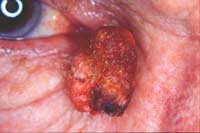| |
Basal Cell Carcinoma
Basal cell carcinoma is a
type of skin cancer that occurs most commonly on the face or neck, often
near an eyelid or on the nose. The tumor cells are thought to originate
from the basal, or deepest layer of skin.

Basal cell carcinoma is the most common type of skin cancer in the
United States. Fair-skinned people over age 50 are most commonly
affected; it is rare among those with dark skin. The incidence increases
significantly with sun exposure. Those who work outdoors or live in
sunny climates or areas with high sun exposure are at greater risk.
The ultraviolet radiation in sunlight is believed to be the cause in
most cases. People with dark complexions have more melanin in their skin
and are able to absorb higher amounts of the damaging ultraviolet rays.
Since those with fair skin have less melanin, they are less able to
withstand the effects of UV exposure.
SIGNS AND SYMPTOMS
•Typically appears on the eyelid (the lower lid is more common than the
upper)
•Begins as a small, raised growth
•Classic appearance is a nodule with a pitted center
•Tumor edges may have a “pearly†appearance
•Does not cause discomfort, but if advanced, may cause lid to turn in or
out
DETECTION AND DIAGNOSIS
If left untreated, the growth may gradually invade the surrounding
tissue. Fortunately, basal cell carcinomas rarely metastasize (spread to
other parts of the body). Diagnosis is made by microscopic examination
of the tumor cells.
TREATMENT
Basal cell can be removed surgically or with radiation. As with any type
of cancer, early detection is important. Consult with an ophthalmologist
or dermatologist about any suspicious growth appearing on the eyelids or
skin.
PREVENTION
Individuals at risk, the fair-skinned, should avoid
overexposure to sunlight. Wear sunglasses to protect the delicate skin
around the eyelids from UV light. Protective clothing, headgear, and
sunscreen are also recommended.
|
|